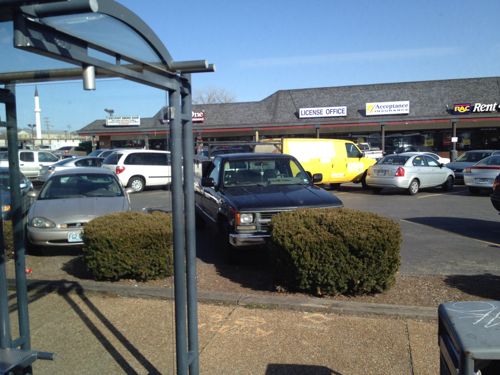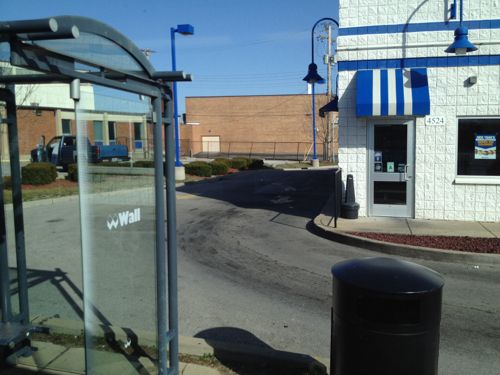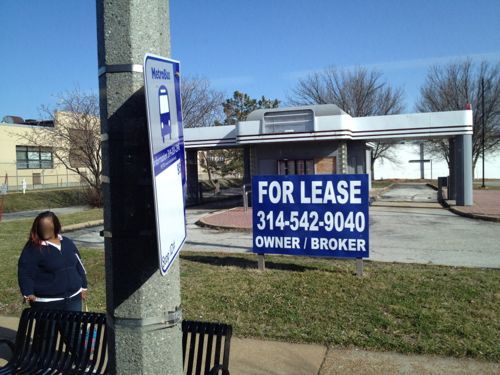Walkability Impacts Number of Pedestrians Using Sidewalks & Transit
The form our buildings take has a direct connection to the number of pedestrians on the sidewalk: streats lined with urban buildings will see more pedestrians than those with anti-urban buildings (read: suburban). Transit riders are pedestrians on part of their journey, but many of us have no choice but to be pedestrians in unfriendly places where few pedestrians are spotted. On a recent ride on a packed #95 (Kingshighway) MetroBus this became clear.



We don’t design buildings to be used by pedestrians. Sure, some will say there are no pedestrians so why should we? I say there are few pedestrians in many places because that is the result of decades of anti-urban policy.
 – Steve Patterson
“We don’t design buildings to be used by pedestrians.” Wrong. Most buildings are designed to be used by able-bodied pedestrians, the exception being drive-thru’s and auto storage, service and repair facilities.  Our buildings have these things called front doors that we use to get inside them. The concerns you raise are related to access for people with disabilities and/or site, not building, design issues.
You provide three examples. The first appears to be successful in that both the parking lot and the storefronts are mostly full – it’s being used and it’s apparently meeting the needs of most of its users. It also appears to be well maintained, which implies that cash flow is positive and the owner is able to fix things as problems occur, something that many parts of town can use more of. The building, itself, is fine, it’s the parking lot that creates a (minor?) barrier to some pedestrians.
Your second example, the White Castle, is a classic example of an autocentric, fast-food business. It generates more business from its drive-thru than it does from its inside, walk-up counter and dining room, and the site design reflects that. Pedestrians, of all abilities, are secondary, and those with disabilities are virtually ignored, with an accessible route, to the other door, from the two accessible parking spaces, but no designated route from the public sidewalk.
Your last example, the former Rally’s, is very autocentric and very vacant. Again, its primary customer base, here and elsewhere, is the drive-thru, not pedestrians. It’s a business decision (and apparently not the best one), as is focusing on cheap, non-nutritious food.
Pedestrians in this part of town ARE a distinct minority. Many businesses apparently have decided that “going the extra mile” to meet their needs is simply not worth the cost, that the added cost won’t generate a greater increase in business. Is it “fair”? No. Does it suck, especially if you’re transit-dependent or disabled? Yes. But to focus on businesses that apparently don’t care seems like a waste of time, kind of like complaining that the self-serve car wash further north doesn’t have a designated pedestrian route, either, or that White Castle doesn’t offer a veggie burger. Focus on those businesses that are both doing the right things and are successful, like the bar south of the White Castle or the real estate office across the street.
If you don’t like these businesses’ business decisions, whether it’s their lack of pedestrian access or the simple fact that they sell crap you wouldn’t want to eat, the response is pretty simple – DON’T PATRONIZE THEM! If businesses don’t make a profit at a specific location (like Rally’s), they get the message and they CLOSE! But it’s also pretty arrogant to assume that just because you choose not to drive that everyone else should, as well. Our built environment reflects the reality that most of us prefer our private vehicles over using public transit, You “say there are few pedestrians in many places because that is the result of decades of anti-urban policy.” I say there are few pedestrians in many places because we’d rather drive and we choose to patronize those businesses who accomodate US!
“We don’t design buildings to be used by pedestrians.” Wrong. Most buildings are designed to be used by able-bodied pedestrians, the exception being drive-thru’s and auto storage, service and repair facilities. Our buildings have these things called front doors that we use to get inside them. The concerns you raise are related to access for people with disabilities and/or site, not building, design issues.
You provide three examples. The first appears to be successful in that both the parking lot and the storefronts are mostly full – it’s being used and it’s apparently meeting the needs of most of its users. It also appears to be well maintained, which implies that cash flow is positive and the owner is able to fix things as problems occur, something that many parts of town can use more of. The building, itself, is fine, it’s the parking lot that creates a (minor?) barrier to some pedestrians.
Your second example, the White Castle, is a classic example of an autocentric, fast-food business. It generates more business from its drive-thru than it does from its inside, walk-up counter and dining room, and the site design reflects that. Pedestrians, of all abilities, are secondary, and those with disabilities are virtually ignored, with an accessible route, to the other door, from the two accessible parking spaces, but no designated route from the public sidewalk.
Your last example, the former Rally’s, is very autocentric and very vacant. Again, its primary customer base, here and elsewhere, is the drive-thru, not pedestrians. It’s a business decision (and apparently not the best one), as is focusing on cheap, non-nutritious food.
Pedestrians in this part of town ARE a distinct minority. Many businesses apparently have decided that “going the extra mile” to meet their needs is simply not worth the cost, that the added cost won’t generate a greater increase in business. Is it “fair”? No. Does it suck, especially if you’re transit-dependent or disabled? Yes. But to focus on businesses that apparently don’t care seems like a waste of time, kind of like complaining that the self-serve car wash further north doesn’t have a designated pedestrian route, either, or that White Castle doesn’t offer a veggie burger. Focus on those businesses that are both doing the right things and are successful, like the bar south of the White Castle or the real estate office across the street.
If you don’t like these businesses’ business decisions, whether it’s their lack of pedestrian access or the simple fact that they sell crap you wouldn’t want to eat, the response is pretty simple – DON’T PATRONIZE THEM! If businesses don’t make a profit at a specific location (like Rally’s), they get the message and they CLOSE! But it’s also pretty arrogant to assume that just because you choose not to drive that everyone else should, as well. Our built environment reflects the reality that most of us prefer our private vehicles over using public transit, You “say there are few pedestrians in many places because that is the result of decades of anti-urban policy.” I say there are few pedestrians in many places because we’d rather drive and we choose to patronize those businesses who accomodate US!
St. Louis’ planners believed that without highways and lots of parking the region would decentralize. Harland Bartholomew argued that parking garages were the modern replacement for subways. They were wrong as lowering congestion, increasing accessibility, cutting transit, and making parking cheap, actually made the city less relevant by removing the advantages of agglomeration. How does this matter today? Those who argue that St. Louis requires auto-oriented forms to compete with suburban areas and the preferences of commuters lessen our inherent strengths. People are moving to Saint Louis City for walkability, transit access, density, and old buildings. St. Louis should engage in building a city for the future rather than continuing to promote out-dated designs which have not brought population growth.
Literature shows a strong connection between urban form and transit usage. This provides the basis for TOD, New Urbanism, and can be validated by looking at cities which developed around transit and never got rid of their systems. The amount of free parking at these sites definitely induces people to use their car. By setting back buildings from the street pedestrians get the message that walking is not desired and actually requires more work. Other cities know this and are taking steps to re-write the rules of development. Of course some business owners may not care, but it is the responsibility of government and our community to put in place structures which guide our development and make us competitive. Of course if St. Louis continues to drive down the path of car dependency the automobile will continue to be the dominant mode of choice! You have to link land use and design with transportation planning.
St. Louis’ planners believed that without highways and lots of parking the region would decentralize. Harland Bartholomew argued that parking garages were the modern replacement for subways. They were wrong as lowering congestion, increasing accessibility, cutting transit, and making parking cheap actually made the city less relevant by removing the advantages of agglomeration. How does this matter today? Those who argue that St. Louis requires auto-oriented forms to compete with suburban areas and the preferences of commuters ignore our inherent strengths. People are moving to Saint Louis City for walkability, transit access, density, and old buildings. St. Louis should engage in building a city for the future rather than continuing to promote out-dated designs which have not brought population growth and do nothing to seperate us from suburban areas.Â
Literature shows a strong connection between urban form and transit usage. This provides the basis for TOD, New Urbanism, and can be validated by looking at cities which developed around transit and never got rid of their systems. The amount of free parking at these sites definitely induces people to use their car.  By setting back buildings from the street pedestrians get the message that walking is not desired and actually requires more work. Other cities know this and are taking steps to re-write the rules of development. Of course some business owners may not care, but it is the responsibility of government and our community to put in place structures which guide our development and make us competitive. Yes, as St. Louis continues to drive down the path of car dependency the automobile remains the dominant mode of choice! For that to change steps have to be taken. Â
“But it’s also pretty arrogant to assume that just because you choose not to drive that everyone else should, as well”
You sound like this  guy.  No one is telling you to stop using a car or use it less.  Global demand for oil will make that happen. I am am saying we should be ready when that happens. We can promote design which accomodates other forms of transportation. That’s a growth market and cities which don’t do that will lose to those which do. We can do it without making driving difficult. Look at our overbuilt roads. Accomodating other forms does not limit the mobility of drivers. This is not controversial. Stuff is being built in St. Louis, we can do it better, and the entire city wins.
St. Louis’ planners believed that without highways and lots of parking the region would decentralize. Harland Bartholomew argued that parking garages were the modern replacement for subways. They were wrong as lowering congestion, increasing accessibility, cutting transit, and making parking cheap actually made the city less relevant by removing the advantages of agglomeration. How does this matter today? Those who argue that St. Louis requires auto-oriented forms to compete with suburban areas and the preferences of commuters ignore our inherent strengths. People are moving to Saint Louis City for walkability, transit access, density, and old buildings. St. Louis should engage in building a city for the future rather than continuing to promote out-dated designs which have not brought population growth and do nothing to seperate us from suburban areas.
Literature shows a strong connection between urban form and transit usage. This provides the basis for TOD, New Urbanism, and can be validated by looking at cities which developed around transit and never got rid of their systems. The amount of free parking at these sites definitely induces people to use their car. By setting back buildings from the street pedestrians get the message that walking is not desired and actually requires more work. Other cities know this and are taking steps to re-write the rules of development. Of course some business owners may not care, but it is the responsibility of government and our community to put in place structures which guide our development and make us competitive. Yes, as St. Louis continues to drive down the path of car dependency the automobile remains the dominant mode of choice! For that to change steps have to be taken.
“But it’s also pretty arrogant to assume that just because you choose not to drive that everyone else should, as well”
You sound like this guy. No one is telling you to stop using a car or use it less. Global demand for oil will make that happen. I am am saying we should be ready when that happens. We can promote design which accomodates other forms of transportation. That’s a growth market and cities which don’t do that will lose to those which do. We can do it without making driving difficult. Look at our overbuilt roads. Accomodating other forms does not limit the mobility of drivers. This is not controversial. Stuff is being built in St. Louis, we can do it better, and the entire city wins.
You may not believe this, but I agree with you. But the place to start is not this stretch of South Kingshighway. This is a stable area that is working, albeit not well for pedestrians. There are many other corridors and more likely places for success, places with better transit and greater residential density, that can lead the way for TOD and higher density in St. Louis. Success breeds imitation. The CWE or the Loop won’t work here for several reasons, but there are places where they can be successfully replicated. We need to focus on incremental success, not trying to force density everywhere, places where there is no real demand for it.
You may not believe this, but I agree with you. But the place to start is not this stretch of South Kingshighway. This is a stable area that is working, albeit not well for pedestrians. There are many other corridors and more likely places for success, places with better transit and greater residential density, that can lead the way for TOD and higher density in St. Louis. Success breeds imitation. The CWE or the Loop won’t work here for several reasons, but there are places where they can be successfully replicated. We need to focus on incremental success, not trying to force density everywhere, places where there is no real demand for it.